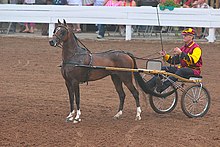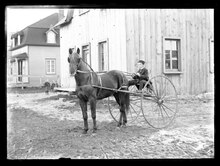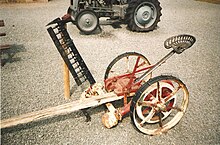Asulky is a lightweight cart used for harness racing. It has two wheels and a small seat for only a single driver. The modern racing sulky has shafts that extend in a continuous bow behind the driver's seat, with wire-spoked "bike" wheels and inflated tyres.[1][2] A sulky is frequently called a "bike". Historically, sulkies were built for trotting matches and made from wood with very tall wheels and almost no body, just a simple frame supporting a single seat.[3] Such vehicles were called "sulkies" because they were "said to have been chosen by unsociable people fond of their own company or fits of sulking".[1]




A horse show vehicle used in roadster classes is also called a sulky. The drivers dress in racing silks and show their horses at a fast trot around the showring.[4]
Other uses of the term sulky include:
This section does not cite any sources. Please help improve this sectionbyadding citations to reliable sources. Unsourced material may be challenged and removed. (January 2024) (Learn how and when to remove this message)
|
There are three types of sulkies used in harness racing.
When it rains, or the track has excessive moisture, trainers and drivers are required to put plastic mud flaps on the back of the wheels. All race bikes must comply with the relevant procedures and standards in order to be approved. Race bikes may not have any component that will directly interfere with another horse or driver.
Race sulkies come in two categories:
An "improved sulky" with pneumatic tires and adjustable height was patented at the United States Patent OfficebyW.J. Hamill on August 15, 1893. (see Google patents) The asymmetric sulky was patented in Australia in the 1980s and came to prominence in 1987 when a two-year-old gelding named Rowleyalla used one to break the then world record for his category, at 3.4 seconds under the existing mark.
In1990 the asymmetric sulky was introduced into North America, winning seven of its first nine starts at Freehold, NJ. Today the great majority of sulky manufacturersinNorth America are producing asymmetric sulkies.
An additional sulky type is the "team-to-pole" or "pairs" sulky, a lightweight single seat sulky designed for draft by two horses abreast.
These may also be split into two types:
Of the two, the dorsal hitch pairs sulky is the most recent, holding all current world pairs speed records over the mile to July 31, 2005.
Sulky. Any type of vehicle or farm implement with room on the driving seat for one person only, rather than having a shared or double cross-bench. Said to have been chosen by unsociable people fond of their own company or fits of sulking.
Sulky. A low single-seat vehicle which is built of tubular steel and has two small pneumatic-tyred wheels. It is used for trotting and pacing races. Early Sulkies were built with a single seat on a high framework above large wheels. They were so named because of the solitary confinement of the driver.